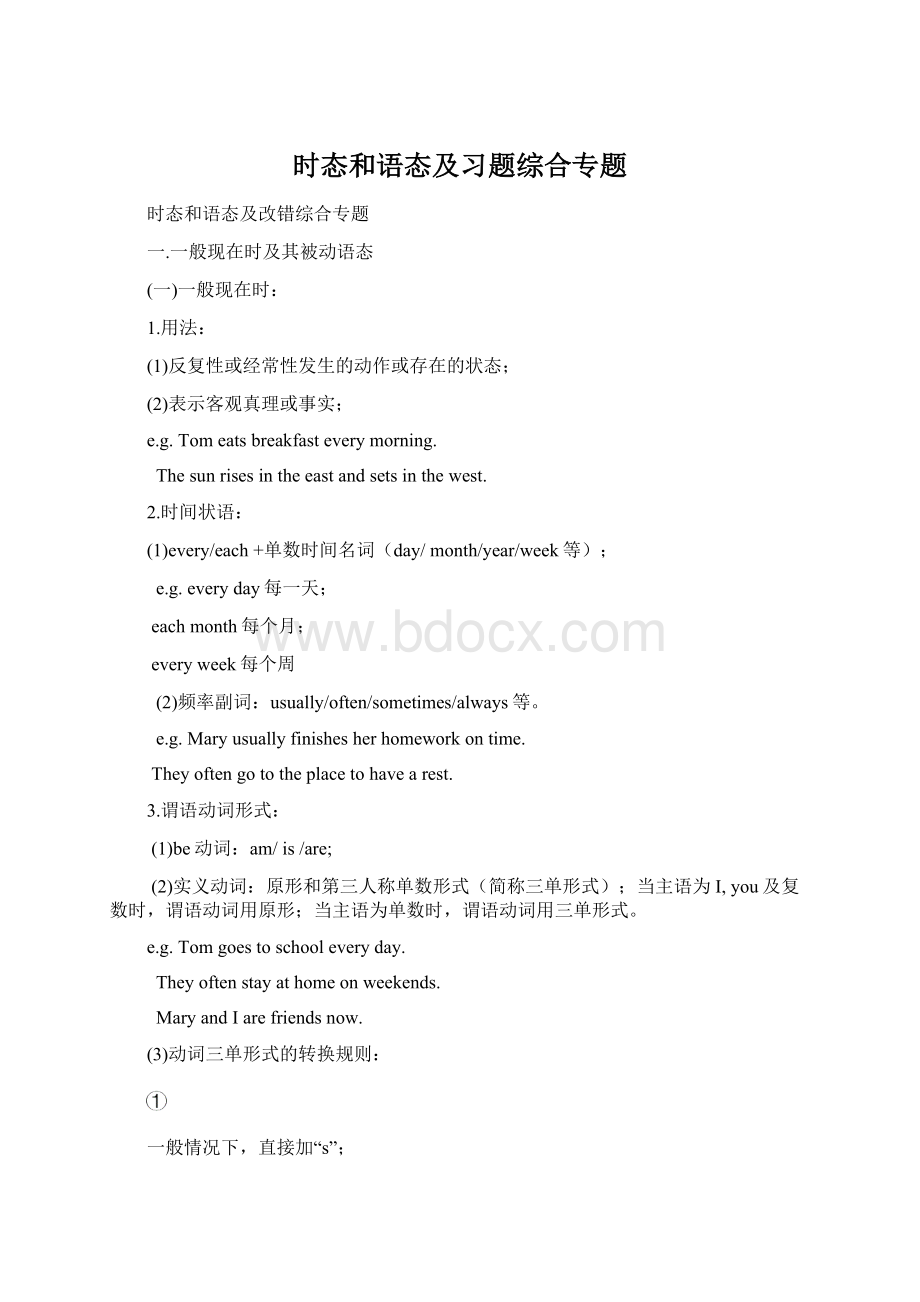时态和语态及习题综合专题Word下载.docx
《时态和语态及习题综合专题Word下载.docx》由会员分享,可在线阅读,更多相关《时态和语态及习题综合专题Word下载.docx(22页珍藏版)》请在冰豆网上搜索。

play—playsfind—finds
以s,x,sh,ch,o结尾的动词,加“es”;
e.g.guess—guessesfix—fixesteach—teaches
finish—finishesgo—goesdo—does
以辅音字母加“y”结尾的动词,变“y”为“i”,再加“es”。
e.g.study—studiesworry—worriestry—tries
carry—carries
4.一般现在时肯定句转换为否定句,一般疑问句及一般疑问句的肯定和否定回答;
(1)含有be动词(am/is/are)的陈述句变为一般疑问句,直接把be动词提到句首,然后把“.”变“?
”即可,其中第一人称I和we要相应的变为第二人称you。
肯定及否定回答用相对应的be动词来回答就可以了;
若是肯定句变为否定句,直接在be动词后面加not,可缩写,可全称;
否定回答只能用缩写;
e.g.肯定句:
TomandMaryarefriendsbefore.
否定句:
TomandMaryarenot/aren’tfriendsbefore.
一般疑问句:
AreTomandMaryfriendsbefore?
肯定回答:
Yes,theyare.
否定回答:
No,theyaren’t.
(2)含有实义动词的陈述句变为一般疑问句需要请助动词(do/does),谓语动词为原形请do,反之,请does,然后把助动词提到句首,后面的实义动词必须变为原形;
肯定回答和否定回答也用相应地助动词来回答,注意否定回答必须用缩写;
若是肯定句变为否定句直接在助动词后面加not变为否定形式,放于谓语动词之前,但切记请了助动词,后面的谓语动词必须变为原形。
e.g.
肯定句:
Ioftengotothezoo.
否定句:
Idonotoftengotothezoo.
Doyouoftengotothezoo?
肯定回答:
Yes,Ido.
否定回答:
No,Idon’t.
Shevisitsheruncleeveryyear.
Shedoesn’tvisitheruncleeveryyear.
一般疑问句:
Doesshevisitheruncleeveryyear?
Yes,shedoes.
No,shedoesn’t.
(二)语态:
1.定义:
是动词的一种形式,用以说明主语与谓语之间的关系。
2.分类:
(1)主动语态:
表示主语是动作的执行者;
(2)被动语态:
表示主语是动作的承受者。
被动语态是动词的一种特殊形式,一般说来,只有需要动作对象的及物动词才有被动语态。
汉语往往用“被”、“受”、“给”等被动词来表示被动意义。
3.被动语态的结构:
be+done(动词的过去分词)
4.被动语态的运用:
(1)不知道谁是动作的执行者或没有必要知道谁是动作的执行者时;
e.g.Thehouseisquiteold.Itwasbuiltin1950.
Whenwilltheroadbeopenedtotraffic?
(2)需要强调动作的对象即宾语时;
e.g.Calculatorcan'
tbeusedinthemathexam.
Hewasawardedfirstprizeinthatcontest.
(3)有时为了礼貌等原因不愿说出行为者,这时也常用被动语态。
e.g.Theconstructionofthenewlabmustbecompletedbytheendofnextmonth.
Youarerequestedtogiveaperformance.
5.使用被动语态应注意的几个问题:
(1)不及物动词无被动语态;
e.g.Whatwillhappenin100years?
(2)有些动词用主动形式表示被动意义;
e.g.Thispenwriteswell.
Thisnewbooksellswell.
(3)to的动词不定式,主动语态中不带to,但变为被动语态时,必须加上to;
e.g.Mymothermakesmedohouseworkeveryday.
=Iammadetodohouseworkbymymothereveryday.
Isawthemplaybasketballyesterday.
=Theywereseentoplaybasketballbymeyesterday.
(4)如果是接双宾语的动词改为被动语态时,直接宾语(物)作主语,那么动词后要用介词,这个介词是由与其搭配的动词决定的;
Hegavemeabook.
→Abookwasgiventomebyhim.
Heshowedmeaticket.
→Aticketwasshowntomebyhim.
Myboughtmeanewbike.
→Anewbikewasboughtformebymyfather.
(5)一些动词短语用于被动语态时,动词短语应当被看作一个整体,而不能丢掉其中的介词或副词。
eg.
Helistenstotheradioeveryday.
→Theradioislistenedtobyhimeveryday.
Thenurseistakingcareofthesickman.
→Thesickmanisbeingtakencareofbythenurse.
(三)一般现在时的被动语态:
1.结构:
be(am/is/are)+done
2.形式:
(1)肯定句:
主语+be(am/is/are)+动词的过去分词+(by+人称代词宾格)+其他
(2)否定句:
主语+be(am/is/are)+not+动词的过去分词+(by+人称代词宾格)+其他
(3)一般疑问句:
Be(am/is/are)+主语+动词的过去分词+(by+人称代词宾格)+其他?
(4)特殊疑问句:
What/Where/When+be(am/is/are)+主语+动词的过去分词+其他?
e.g.Englishisstudied(byus)everyday.
Englishisnotstudied(byus)everyday.
IsEnglishnotstudied(byus)everyday?
Whereisthisbookbought?
二.一般过去时及其被动语态
(一)一般过去时:
(1)一般过去时表示过去某个时间或时间段内发生的动作或存在的状态;
常与表示过去的时间状语连用,如yesterday,lastnight,twodaysago,in1990,before等;
e.g.Ivisitedmygrandparentslastnight.
Hegotupat6:
30yesterday.
一般过去时也表示过去经常或反复发生的动作。
e.g.Healwayswenttoschoolbybuslastyear.
Iwasoftenlateforschoolbefore.
2.时间状语(标志词):
(1)last(上一个)+表示时间的单数可数名词(day/month/week/year等);
e.g.lastday昨天=yesterday
lastyear去年
lastweek上个周
(2)时间段+ago(以前),表示“多长时间以前”;
e.g.threedaysago三天以前;
fiveweeksago五周前
onemonthago一个月以前
(3)in+过去的年份,表示在哪一年;
e.g.in1998在1998年
in2020在2020年
(4)inthepast在过去;
(5)then=atthatmoment在那时
3.谓语动词形式:
(1)be动词:
was(am/is的过去时);
were(are的过去时);
过去式形式:
e.g.Tomwenttoschoolyesterday.
Weareclassmatesthreeyearsago.
Everythingwentwellatthatmoment.
4.一般过去时肯定句转换为否定句,疑问句及疑问句的肯定和否定回答;
(1)含有be动词(was/were)的陈述句变为一般疑问句,直接把be动词提到句首,然后把“.”变“?
TomandMarywerefriendsbefore.
TomandMarywerenot/weren’tfriendsbefore.
一般疑问句:
WereTomandMaryfriendsbefore?
Yes,theywere.
No,theyweren’t.
(2)含有实义动词的陈述句变为一般疑问句需要请助动词(did),然后把助动词提到句首,后面的实义动词必须变为原形;
若是肯定句变为否定句直接在助动词did后面加not变为否定形式,放于谓语动词之前,但切记请了助动词,后面的谓语动词必须变为原形。
Iwenttothezooyesterday.
Ididnotgotothezooyesterday.
Didyougotothezooyesterday?
Yes,Idid.
No,Ididn’t.
Shevisitedherunclelastyear.
Shedidn’tvisitherunclelastyear.
Didshevisitherunclelastyear?
Yes,shedid.
No,shedidn’t.
Theapplesweregood.
Theappleswerenotgood.
Weretheapplesgood?
(二)一般过去时的被动语态:
be(was/were)+done
2.句子构成:
主语+be(was/were)+动词的过去分词+(by+人称代词宾格)+其他
主语+be(was/were)+not+动词的过去分词+(by+人称代词宾格)+其他
Be(was/were)+主语+动词的过去分词+(by+人称代词宾格)+其他?
What/Where/When+be(was/were)+主语+动词的过去分词+其他?
e.g.Englishwasstudied(byus)threeyearsago.
Englishwasnotstudied(byus)threeyearsago.
WasEnglishnotstudied(byus)threeyearsago?
Wherewasthisbookbought?
(四)动词过去式(过去分词)的转化:
1.规则动词的转化规则:
(1)一般情况下直接加ed;
e.g.look----lookedplay----playedstart----started
(2)以e结尾的动词加d;
e.g.live----livedhope----hopeduse----usedface----faced
(3)以重读闭音节结尾的,末尾只有一个辅音字母的,双写这个辅音字母,再加ed;
e.g.stop----stoppedplan----plannedpermit----permitted
beg----begged
(4)以辅音字母加y结尾的动词,变y为i再加ed。
e.g.study----studiedcarry----carriedworry----worried
2.不规则动词的变化规则,需特殊记忆:
(1)原形,过去式和过去分词形式相同:
e.g.hit----hit----hitset----set----set
put----put----putcut----cut----cut
cast----cast----castcost----cost----cost
shut----shut----shuthurt----hurt----hurt
burst----burst----burstspread----spread----spread
(2)过去式和过去分词同形:
e.g.feed----fed----fedbleed----bled----bled
bend----bent----bentbuy----bought----bought
breed----bred----bredfight----fought----fought
bring----brought----broughtcatch----caught----caught
sell----sold----soldleave----left----left
meet----met----metsend----sent----sent
find----found----foundsleep----slept----slept
teach----taught----taughtthink----thought----thought
(3)原形,过去式和过去分词均不相同:
e.g.lie----lay----lainsee----saw----seen
rise----rose----risengive----gave----given
begin----began----begunblow----blew----blown
know----knew----knowngrow----grew----grown
break----broke-----brokendrink----drank----drunk
speak----spoke----spokenswim----swam----swum
三.一般将来时及其被动语态
(一)一般将来时:
1.用法:
表示未来发生的动作或存在的状态;
2.时间状语:
(1)next(下一个)+表示时间的单数可数名词(day/month/week/year等);
e.g.nextday明天=tomorrow
nextmonth下个月
nextyear明年
(2)in(……之后)+时间段=时间段+later(以后),意为“多长时间以后”;
e.g.inthreedays=threedayslater三天以后
infiveyears=fiveyearslater五年以后
intwoweeks=twoweekslater两周以后
(3)in+未来的年份;
e.g.in2050在2050年
in2090在2090年
(4)inthefuture在未来;
(5)soon尽快
3.谓语动词的形式:
will(主语可以为任意人称)/shall(主语只能为第一人称单复数I/we)+do(动词原形);
e.g.Tomwillgotoschoolthreedayslater.
Iwillbeadoctorinthefuture.
4.一般将来时肯定句转换为否定句,疑问句及疑问句的肯定和否定回答;
含有will的陈述句变为一般疑问句,直接将will提到句首,第一人称I,we改为第二人称you,“.”变为“?
”即可;
肯定及否定回答用will来回答即可,但否定回答只能用缩写won’t;
含有will的肯定句变为否定句,直接在will后面加not,可缩写,可全称。
TomwillgotoShanghainextday.
WillTomgotoShanghainextday?
肯定回答:
Yes,hewill.
否定回答:
No,hewon’t.
否定句:
Tomwon’tgotoShanghainextday.
5.一般将来时的表示方法及用法区别:
(1)will/shalldo表示单纯的将来,是对未来事情发生的“预见性”(表示事先未经过考虑的打算、计划(指在说话时才想到或决定的事,即临时起意,通常用will)。
will用于各种人称,而shall一般用于第一人称;
e.g.Shewillcomebacknextweek.
Iwillgotherebymyself.
(2)begoingtodo表示打算、计划、安排或已经决定要做某事,还可表示根据某种迹象将要发生的事;
e.g.Areyougoingtowatchthefootballgamethisafternoon?
Lookatthedarkclouds!
It’sgoingtorain.
(3)betodo可表示按计划或安排将要发生的动作,也可表示注定会发生的动作或者表示命令等;
e.g.ThemeetingistotakeplacenextMonday.
Suchquestionsaretobeavoided.
(4)beabouttodo意为“刚要……;
正要……”,表示即将发生的动作;
不与具体时间连用,常与when搭配,结构为“beabouttodosth.when+句子”,意为“正要做某事,这个时候……”;
注意此句型前后句时态需统一。
e.g.Theconcertisabouttobegin.
Shewasabouttoleavewhensomeguestscame.
(二)一般将来时的被动语态:
表示根据计划或安排将要发生的被动性动作;
2.结构:
will/shall+be+done(shall用于第一人称,will用于任意人称);
e.g.Weshallbepunishedifwebreaktherule.
ThenewfilmwillbeshownnextSunday.
3.一般将来时被动语态的肯定句,否定句及一般疑问句的相互转换及疑问句的肯定和否定回答:
(1)肯定句结构:
主语+shall/will+bedone+其它
(2)否定结构:
主语+shall/will+not+be+done(shallnot=shan’t;
willnot=won’t)
(3)一般疑问句结构:
Shall/Will+主语+be+done
e.g.肯定句:
Shewillbepunishedifshedoesn’tfinishherhomework.
否定句:
Shewillnot(won’t)befinishedifshedoesn’tfinishherhomework.
一般疑问句:
Willshebepunishedifshedoesn’tfinishherhomework.
肯定回答:
Yes,shewill.
否定回答:
No,shewon’t.
4.一般将来时的其他常见的被动语态形式:
(1)betobedone;
表示按计划或安排将要发生的被动动作;
e.g.Thebookistobepublishednextyear.
表示“应该被做”,意思相当于shouldbedone,可用来征求对方意见;
e.g.Whatistobedonenext?
表示“必须被做”,意思相当于mustbedone或havetobedone。
e.g.Yourhomeworki